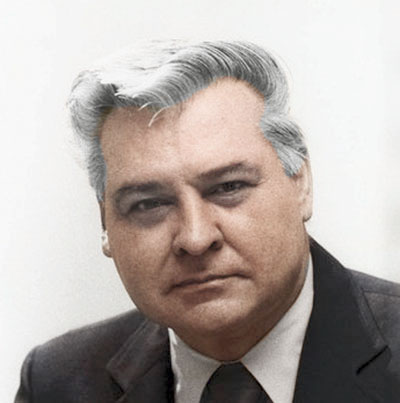HOME | FAMILY | CONDUCTING | SINGING | USU | STEINER | STANFORD | PHOTOS
26th AMENDMENT SIGNING | MEMORIES | YOUTUBE VIDEOS
Our Growing Family (Many Years Ago)
After graduating from Somerset (Kentucky) High School I entered the University of Kentucky as a freshman majoring in music. My original intent had been to become a Baptist minister, but my talents and interests had always been in music. During my 2nd year in college, I met the most stunningly beautiful young woman – who, at that time was dating another guy (also from my high school.) I immediately had a crush on Phyllis. but she was already spoken for. Beginning my junior year, however, she and her former boyfriend had split up and I was the most fortunate young man in the world because she and I started dating on September 27, 1957, and before Christmas, we were engaged.
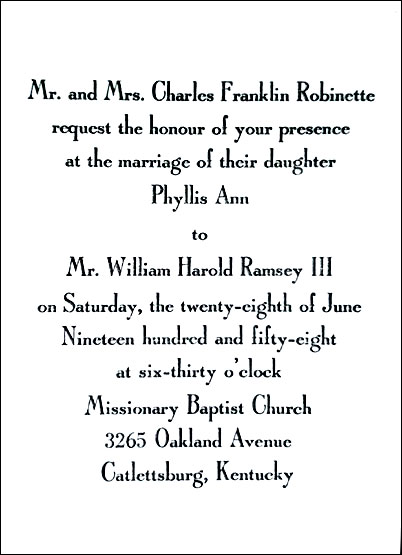
Wedding Invitation
- June 28, 1958
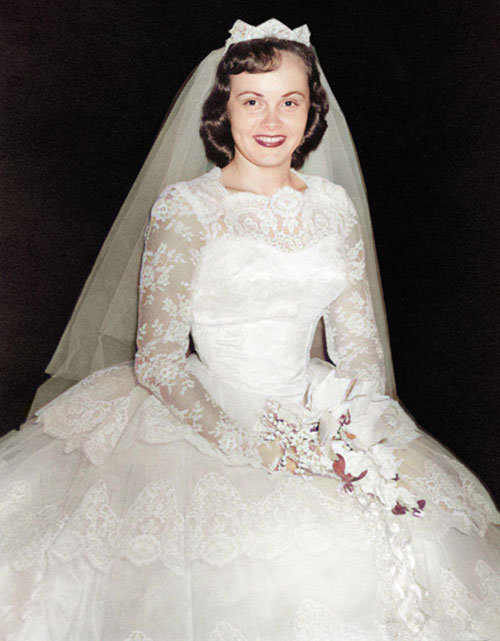
Phyllis - Wedding Dress
We married 6 months later. Our honeymoon was spent in San Diego where I was attending a summer choral music workshop. We left Kentucky and drove (mostly on Route #66 – a 2-lane road) across the country and lived in a small apartment just off the San Diego State University campus. We ate our first taco and had tortilla chips – an unheard-of delicacy until that time. (This was long before the days of Fritos!) The only Mexican foods I remember before our San Diego trip were "hot tamales" and chili out of a can! Boy have things changed.
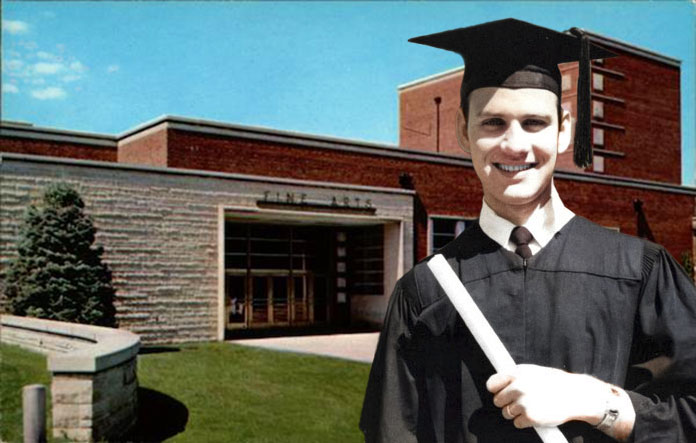
Bill - Ready to Graduate
After graduation from the University of Kentucky, my parents drove us to New York City for me to enroll in Union Theological Seminary, School of Sacred Music – located on 122nd street and Broadway.
Union was directly across the street from the Juilliard School of Music (where I studied voice) and the Jewish Theological Seminary. We had a tiny room in the married students’ dormitory (Hastings Hall) with only a trundle bed and a small fridge. The bathrooms and kitchen were shared by all the students and were down the hall from our room.
Phyllis immediately got a job as a receptionist and secretary at the Graduate School of Business at Columbia University – right up the street from Union. Her southern charm immediately captivated all who came in contact with her and she was beloved at Columbia. She would answer the telephone, “Graduate School of Business, Mrs. Ramsey speaking” in her southern drawl and the voice on the other end of the line (using a fake southern accent) would frequently say, “Well hello there, honey, what part of the south are you from.”
During our 2nd year at Union, we thought, perhaps, that Phyllis had become pregnant. We went home to Kentucky for Christmas and Phyllis made an appointment with a local doctor, a long-time family friend. He examined Phyllis and performed a pregnancy test on her (which took several hours to receive the results after she had left the doctor’s office.) Later that day, or perhaps the next day, Dr. Morris Holtzclaw called and said, “Phyllis honey, the rabbit died” (a normal means of stating a positive test for pregnancy in those days.) We were thrilled and ecstatic driving back to New York after the holidays looking forward to the birth of our first child.
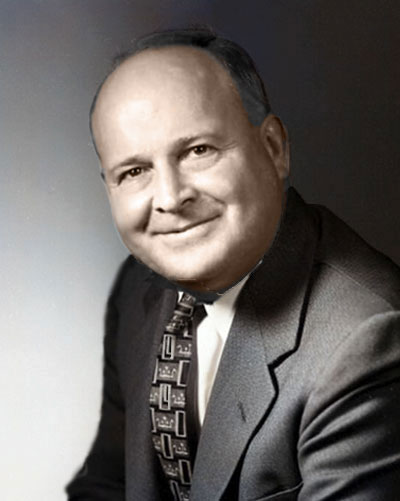
Dr. Morris Holtzclaw
Phyllis suffered (almost immediately) from severe "morning sickness" (nausea, vomiting.) Often she would awake and plead with me to get her a "cracker." Before I could carry out her wish, she would vomit and, soon thereafter, depart for work at Columbia University. Because we had not yet announced our pregnancy to anyone other than members of the family, her "boss" Walter Smith, Dean of the Graduate School of Business, suspected because Phyllis often would spend a good bit of time in the restroom attempting not to "loose her lunch." Walter confided with one of the office employees, "I sure hope Mrs. 'R' is not expecting."
One day, Phyllis was walking home from Columbia for lunch when she had a sudden bleed and we were horrified that we would lose the baby. We called several Ob/Gyn doctors in New York and eventually found a wonderful doctor, Dr. Vincent Freda, who assured us that if we lost this baby we knew that Phyllis could become pregnant again.
We returned to Kentucky after I had graduated from Union and for Phyllis to give birth to our first baby. Because Phyllis was already overdue and Dr. Holtzclaw had recently lost a baby at birth, he decided to induce Phyllis. She entered the hospital and was given an IV to begin the labor process. She labored all night with no results. The next morning Dr. Holtzclaw came into her room and announced that he thought we should have a Cesarean section delivery. She was prepped and shortly we had a beautiful baby girl. Because Phyllis’ water had apparently broken prior to the c-section, when Dr. Holtzcalw made the incision, he made a slight cut on the baby’s right temple. Also, because there had been some recent infection in the hospital, I was not allowed to see or hold our baby until Phyllis was released from the hospital. No husbands were allowed in the delivery room in those days.
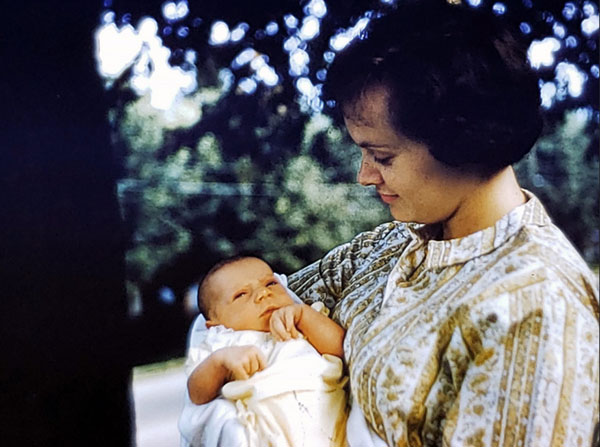
Phyllis with Cheri (a few days old)
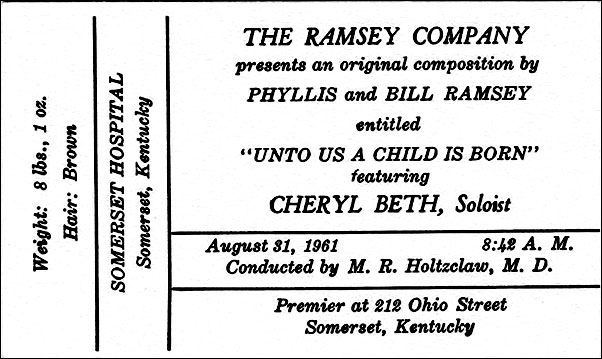
Cheri -Birth Announcement
We had previously applied for low-rent housing ($35 per month) in New York City and I was told that I must be there in person to sign the lease on the day after Phyllis gave birth. Immediately after the delivery I drove to Lexington and got on a plane to New York to sign the lease and returned to Kentucky the same day to be with Phyllis.
Phyllis had just been given her meal when a young man came into her room and began talking. He said to me, “Is that your wife?” I answered that it was. He then asked, “Is she sick?” I said. “No, she just had a baby.” He said, “So did mine. Is this your first, ’un?” I said that it was, and then asked if this was his first child. He said, “No, this is my 8th 'un. But this is the first we didn’t have at home. She wanted to get something with this 'un but we got here too late.” He giggled. We had remembered a woman being rapidly wheeled by Phyllis' hospital room screaming loudly, and assumed it was her.
He then started telling me about his youngest child. “He clumb up on top of the outhouse to put some tar paper on the roof and slipped and fell and busted his livers wide open. You know, your livers hang like a fork.” He was so authentic and so rural. Phyllis had just had a c-section and laughing wasn’t comfortable for her. It was, however, one event we have recalled frequently.
A week or so later, I loaded up our Volkswagen beetle and drove to New York, and a few days later (when Cheri was only 10 days old) Phyllis and Cheri arrived by airplane. We moved into our new apartment – on the 20th floor of a 21-floor building on 125th Street between Broadway and Amsterdam Ave. We quickly learned about the roach infestation which plagued Harlem.
Not long thereafter, it appeared that Phyllis might be pregnant once again. We made an appointment with Vincent Freda at Columbia Presbyterian Hospital and found out that we were expecting another baby to be born only 13 months after Cheri arrived. We were thrilled. 2 months before the birth of our 2nd baby, Dr. Freda asked if there was a history of twins in our family. We knew of none at that time. He requested that we have an x-ray to determine if we were expecting two instead of one baby. Yep! Cheri had been born on August 31, 1961, and on October 15, 1962, Chris and David were born. We lived in Harlem with 3 children in diapers and we had no laundry facilities. Thank Goodness for diaper service and the laundromat!
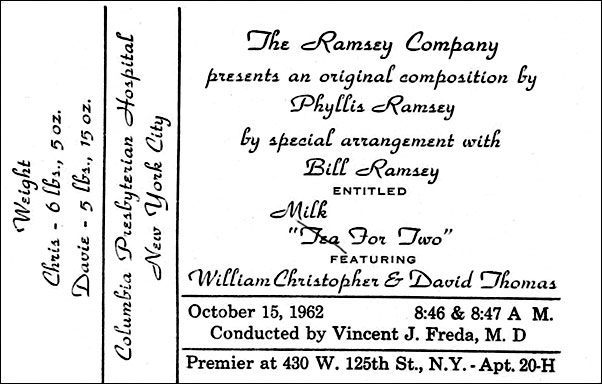
Chris and David - Birth Announcement
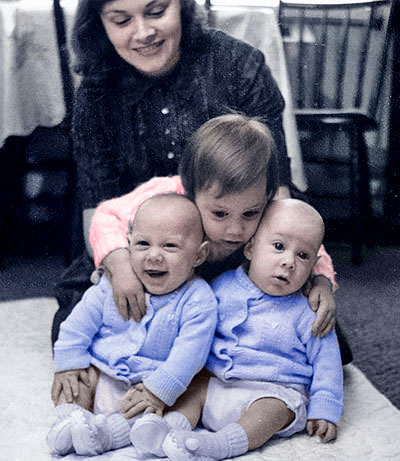
Phyllis with Cheri, Chris and David
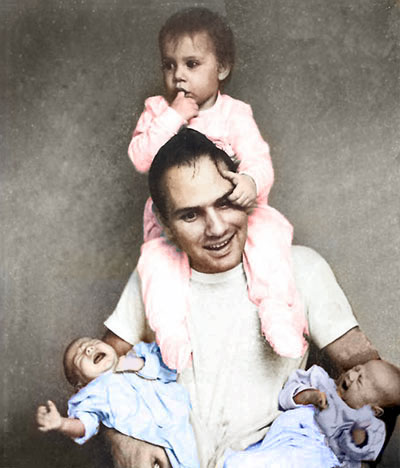
Multitasking?
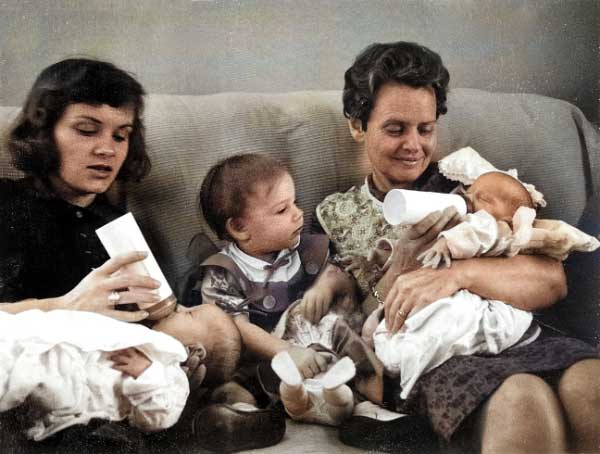
Phyllis, Cheri, Chris, David, and Grandmama Ramsey
I am constantly amazed when I recall the grace with which Phyllis managed those first few months (and, really, all of our marriage - 64+ years as of this writing.) After the birth of our twin boys, I was working full time at the New York Public Library, attending classes (also full time) at Columbia University Teachers College enrolled in the doctoral program, serving as Assistant Conductor of Cantata Singers (one night a week), serving as Conductor of the Summit New Jersey Chorale (one night a week), was a paid baritone in the choir of the Church of the Incarnation (one night per week), and, on frequent occasions, was either a soloist or chorus member for performances in New York City. I was almost never home and Phyllis did all the cooking, taking care of 3 tiny tots, and was the happiest, calm, supportive person I have ever known. How did she do that with virtually no assistance from me? She was (and is) a wonder!
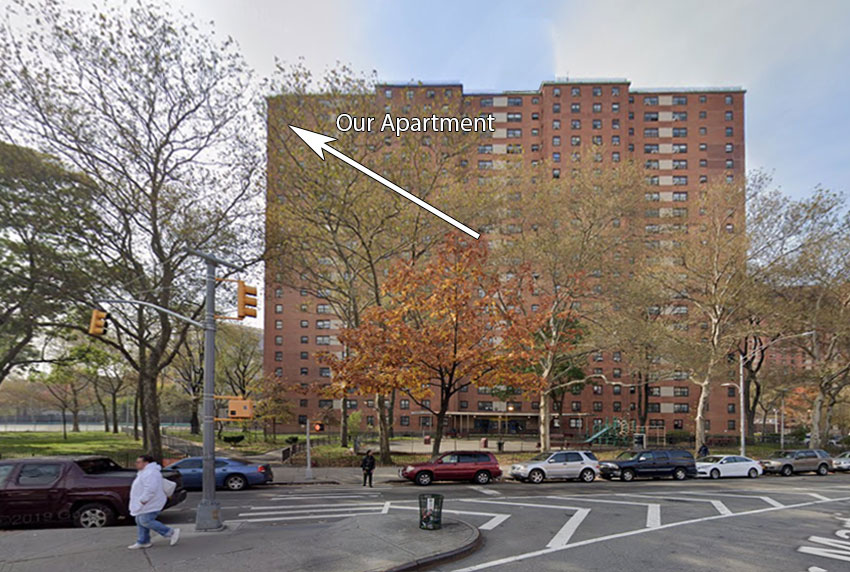
Our apartment 430 West 125th Street - The General Grant Housing Project, New York City
Dr. Vincent Freda
One morning when Phyllis was watching TV she saw her ob/gyn, Dr. Freda who delivered our boys, being interviewed on Good Morning America. She learned that in 1963 he had developed the Rh-negative factor vaccine - Rh immunoglobulin (RhoGAM.) Until his discovery, when a “blue baby” was born, a full exchange of blood was necessary or the baby might not survive.
The following is quoted from the 1980 Albert Lasker Clinical Medical Research Award:
From his first-hand experience in delivering babies who were ill, anemic, brain-damaged or threatened with death because of Rh-incompatibility with their mothers, Dr. Freda determined as a young obstetrician to seek means of preventing Rh disease. From his mentor, Dr. Alexander Weiner, Dr. Freda acquired the insight that the disease arose from immunological origins that could be controlled once they were understood.
While searching for clues, Dr. Freda endeavored to help Rh-afflicted infants in every way possible at the time, thus becoming a pioneer in fetology. He established the first clinic for Rh-negative mothers, and introduced such techniques as amniocentesis and intrauterine blood transfusions in the United States.
Working with Dr. John Gorman, Dr. Freda deduced that if anti-Rh antibody were given at the time of delivery, it would block sensitization and prevent Rh disease in the woman's next Rh-positive child.
Although his colleagues scorned the idea, Dr. Freda and Dr. Gorman set out to test this brilliantly simple concept, using pure antibody supplied by Dr. William Pollack. It was tested first among volunteers at Sing Sing penitentiary, and in a limited study among previously unsensitized Rh-negative women.
It was immediately clear that the vaccine was effective and by 1964, it was evident that Dr. Freda's compassionate determination had led to an advance which could save the lives of thousands of newborn children.
To Dr. Freda, for his abiding concern for the mothers and unborn children in his care, which impelled him to seek an answer to hemolytic disease of the newborn, this 1980 Albert Lasker Clinical Medical Research Award is given.
--Quoted from the 1980 Albert Lasker Clinical Medical Research Award, presented to Dr. Freda.
CLICK HERE for more information.
For Dr. Freda's obituary in the New York Times, CLICK HERE.
To download Giving Babies a Fair Shot (pdf) click here

